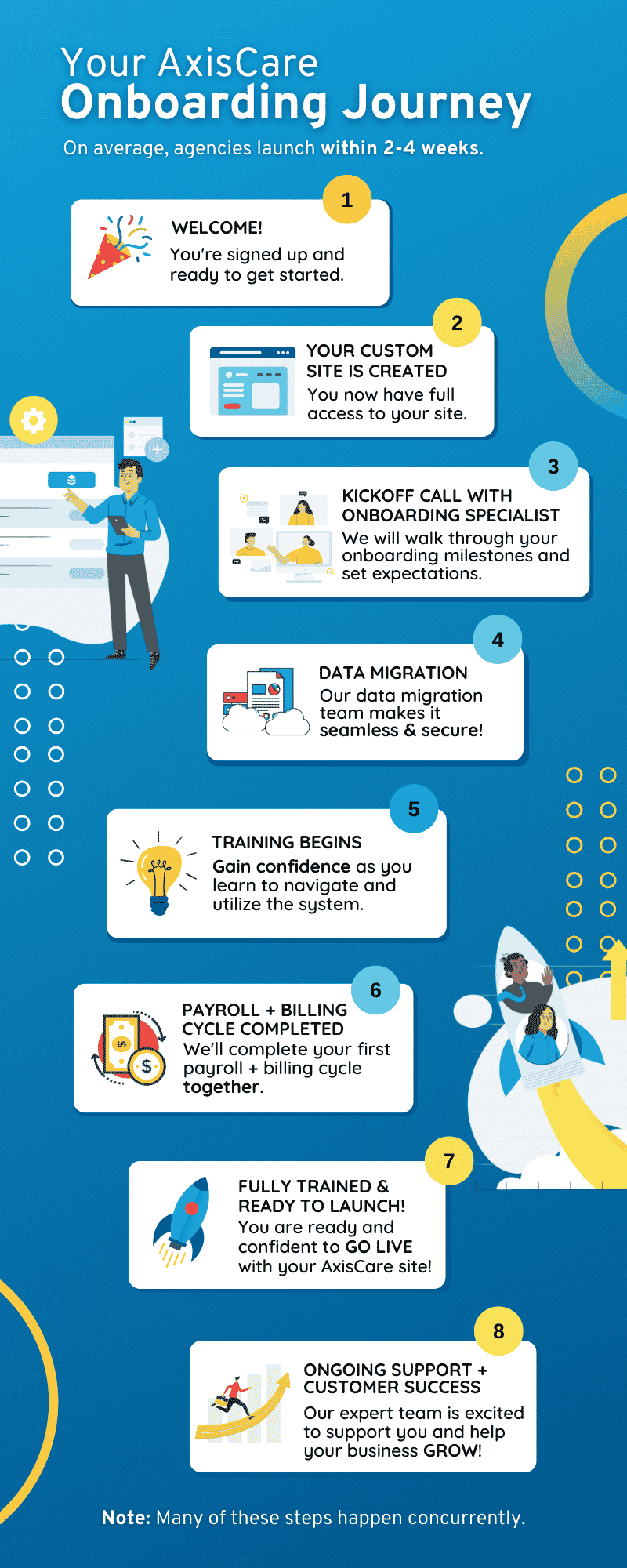With the high competition for quality workers as many shifts occur in the US labor market following the COVID-19 pandemic, employers are finding themselves looking for ways to attract and retain quality employees with appealing benefits to combat the caregiver shortage.
These benefits can come in the form of both paid and unpaid perks. We’ve included paid caregiver incentives because let’s face it, that’s often the most immediate need. However, cash isn’t always a top incentive and for employers that can’t afford to pay more, there are some creative ways to incentivize employees without digging into your bottom line.
72% of employees out of over 1,000 surveyed say that an improvement in work benefits would result in increased job satisfaction. The most valuable asset to any home agency is its caregivers. Benefits directly impact caregiver motivation and incentivize employees to increase productivity. Improved productivity can in turn lead to satisfied clients and business growth.
Increasing your retention rate for home caregivers is possible with an effective home care staffing system that fairly compensates employees with valuable benefits. The important word here is “value.” Internal and external research and surveys can help you determine what your caregivers value as an employee benefit.
The Impact of the COVID-19 Pandemic on Labor
There are about 3.5 million fewer people in the June 2021 workforce relative to the February 2020 workforce. Now that the world is beginning to open back up, why aren’t workers rejoining the workforce? Many theorize the issue is that unemployment benefits are too high, but as state unemployment benefits spurred by the pandemic are starting to recede, employers may not see the change they anticipate.
The real issue, according to a recent Forbes story, might be a permanent change in our labor force with a shrinking US labor pool. With fewer workers available, employers don’t have the luxury of being able to choose from multiple candidates.
Employers are examining their benefits and pay schedules to remain competitive as Americans are looking for better labor conditions after working from home sparked a reassessment from many Americans.
7 Top Benefits to Retain Caregivers
1. Holiday Leave, Sick Leave, and Time Off
Nike is one of the largest and most successful companies known around the world. The success of their company is often, in part, attributed to how they treat their employees by prioritizing paid time off as their second most important benefit. Time off and leave facilitates happy employees. While most companies don’t have the resources that Nike does, there are some things we can learn from their example.
In the home care industry, caregivers experience long days that can result in emotional and physical stressors. The vitality of clients relies heavily on well rested and recharged caregivers. While paid time off and paid sick leave are the most coveted benefits, employees also appreciate flexibility in scheduling and sometimes a shorter work week. Many companies are considering the benefits of a shorter work week in improving efficiency, reducing absenteeism and improving balance and loyalty.
Flexibility and time off show your employees that you value their wellness and desire to support balance in their lives.
2. Travel Reimbursement
Travel can take a toll on individuals and their vehicles and is inherently part of the job of being a home caregiver. This should be the top priority of reimbursement for caregivers to help meet the daily requirements of the commute to and from client’s homes
Efficient ways to pay travel reimbursement:
- Research: The average to standard cost per mile. The IRS standard mileage rate for 2021, also known as the safe harbour rate, is 56 cents, down from 57.5 cents in 2020. Some of this was due to lower fuel rates during the pandemic and lower depreciation rates because of inventory shortages. This reimbursement benefit is valued because it’s often a tax-free benefit. The specific amount can be determined by your agency.
- Stay Organized. Train your caregivers to keep a daily log and record of all trips they completed for their client. All mileage, notes, travel time, and expenses can be documented on the Caregiver Mobile App.
- Set Guidelines. Have an effective system for accountability. You may want to set guidelines to ensure caregivers only log for their personal vehicle and retain screenshots of their mileage from their GPS.
3. 401(k) Matching/ Retirement Plans
401(k) matching demonstrates that you care and want to invest in your caregivers’ financial futures. 67% of people prefer a good 401(k) when evaluating a job offer and 46% say that offering a 401(k) match played a role in accepting a job. There are several benefits to providing 401(k) matching for employees:
- Reduced hidden costs: If home agency staffing does not provide retirement plans, it can create a spiraling effect that could lead to longer employee hours. Longer hours cause more medical fees, call outs, and cause more absence without leave.Therefore, in the long term output is lower productivity.
- Improved retention: preventing financial stress and improving the wellness of employee performance. Poor productivity can lead to higher employee turnover.
- Employer tax deduction: matching 401(k) contributions benefits an agency with tax deductions that can be subtracted from your home care agency’s taxable income as well as providing employees with larger retirement funds.
4. Health & Life Insurance Plans
Caregivers have close contact with their clients to often include contact with bodily fluids, exposure to illness, and challenging physical work to meet their needs while in their care. Health insurance is considered the top benefit for employee retention.
In the midst of the pandemic, this has become even more vital. Providing healthcare packages helps with the longevity of your caregivers being on the job. Additionally, employer-paid health insurance premiums are exempt from federal income and payroll taxes and the employee portion of premiums is typically excluded from taxable income.
5. Child Care
Caregivers with children younger than twelve will benefit from this resource the most. Home agencies could contract with a local child care program or provider to offer dependent care services or even negotiated rates and extended hours for caregivers. Due to a caregiver’s schedule, child care can be a point of stress and unreliable care could lead to absenteeism. This benefit could be paid or supplemented care, or an unpaid benefit that provides the resources to help facilitate the childcare search for parents. Showing you care about employee dependents increases loyalty and trust between the home agency and the caregivers.
Many states offer employers who provide child care services an annual tax credit if used with a qualified child care service. For more information, read more on subsidies.
6. Certification Trainings & Mental Health Check-Ins
To facilitate business growth, employers invest in their people.Home care is an evolving field and caregiver certifications can benefit employees and clients.
Training and Certifications can include:
- First Aid
- Client Hygiene and Personal Care
- Home Safety Training
- Caring for a Hospice Client
- Alzheimer’s/Dementia
- Nutrition & Self Care
- Understanding equipment (Wheelchairs, gait belts)
- Understanding the Signs of Elder Abuse
Up to date training sessions are essential to ensure caregivers meet the needs of clients. AxisCare partners with CareAcademy to facilitate senior caregiver training to empower care professionals to improve the lives of clients.
Being a caregiver can be physically and mentally draining. Checking in on your employees’ mental health shows them that their overall health is a priority. Some ways to check in on mental health is to host events, speakers or themes and education around mental well being. Some ideas are hosting events like Wellness Wednesdays, Foodie Fridays, or Mindful Mondays. Taking time to focus on mental health will contribute to ensuring employees enjoy coming to work.
7. Education Reimbursement
Many college and graduate students work as caregivers. They are often working to pay for college tuition in addition to providing their basic housing needs. Education reimbursement can mutually benefit both agency owners and caregivers.
Home agencies can provide up to $5,250 in college tuition and books and the entire contribution is non-taxable. Caregivers are not taxed on this portion of compensation. This pay strategy can be planned out based on the minimum wage of your state and the goal amount for education reimbursement.
An example from Care.com for caregivers, suggests that instead of being paid wages of $15 per hour, an employee might offer $9 per hour (or whatever the state minimum wage is) and the difference in pay would go to to reimburse the employee for tuition and books, thus reducing the tax liability of both the employee and caregiver. This tax strategy can save your home agency money over time while helping a student caregiver reach their education goals.
Looking for More Ideas?
These suggestions are some of the top benefits to attract caregivers. This list of 47 Ideas For Employee Benefits For Caregivers offers a more detailed list of benefits employers can offer.
After a particularly challenging period or to celebrate successes or holidays, show your caregivers appreciation with some of these incentives.
AxisCare provides home care agencies with a cost-effective scheduling and management software designed to ease your daily workload and manage your home care agency with confidence – allowing you to focus on providing quality care.









